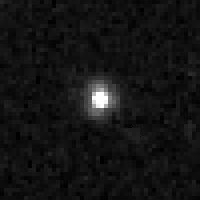 Hubble Space Telescope image of 2003 QX113 taken in 2006 | |
| Discovery[1][2] | |
|---|---|
| Discovered by | CFEPS[3]: 8 |
| Discovery site | Mauna Kea Obs. |
| Discovery date | 31 August 2003 |
| Designations | |
| 2003 QX113 | |
| L3q03[3] | |
| Orbital characteristics[4] | |
| Epoch 1 July 2021 (JD 2459396.5) | |
| Uncertainty parameter 2[1] · 3[4] | |
| Observation arc | 14.34 yr (5,236 d) |
| Aphelion | 62.238 AU |
| Perihelion | 37.674 AU |
| 49.956 AU | |
| Eccentricity | 0.2459 |
| 353.09 yr (128,966 d) | |
| 141.21° | |
| 0° 0m 10.08s / day | |
| Inclination | 6.7261° |
| 158.07° | |
| 26.381° | |
| Physical characteristics | |
| 423 km (est.)[5][8] | |
| 22.85[9] | |
| 5.1[1][4] | |
(612584) 2003 QX113 is a large trans-Neptunian object from the scattered disc located in the outermost region of the Solar System. It is one of the most distant objects from the Sun at 60.5 AU. It was discovered by astronomers with the Canada–France Ecliptic Plane Survey at Mauna Kea Observatories, Hawaii, when it was near aphelion on 31 August 2003. It was provisionally designated 2003 QX113.[1]
- ^ a b c d Cite error: The named reference
MPC-objectwas invoked but never defined (see the help page). - ^ Cite error: The named reference
MPEC-2006was invoked but never defined (see the help page). - ^ a b Cite error: The named reference
Petit-2011was invoked but never defined (see the help page). - ^ a b c d Cite error: The named reference
jpldatawas invoked but never defined (see the help page). - ^ a b Cite error: The named reference
Johnston-TNOswas invoked but never defined (see the help page). - ^ Cite error: The named reference
MPEC-2010was invoked but never defined (see the help page). - ^ Cite error: The named reference
Buie-DESwas invoked but never defined (see the help page). - ^ Cite error: The named reference
hwas invoked but never defined (see the help page). - ^ Cite error: The named reference
AstDys-objectwas invoked but never defined (see the help page).